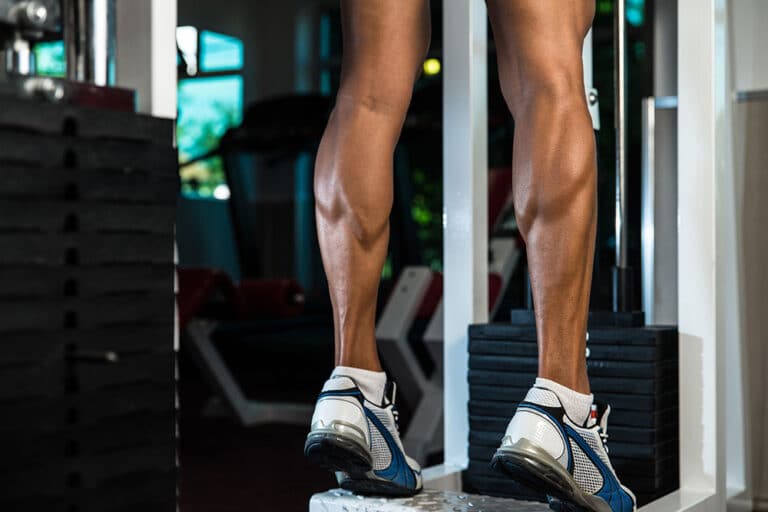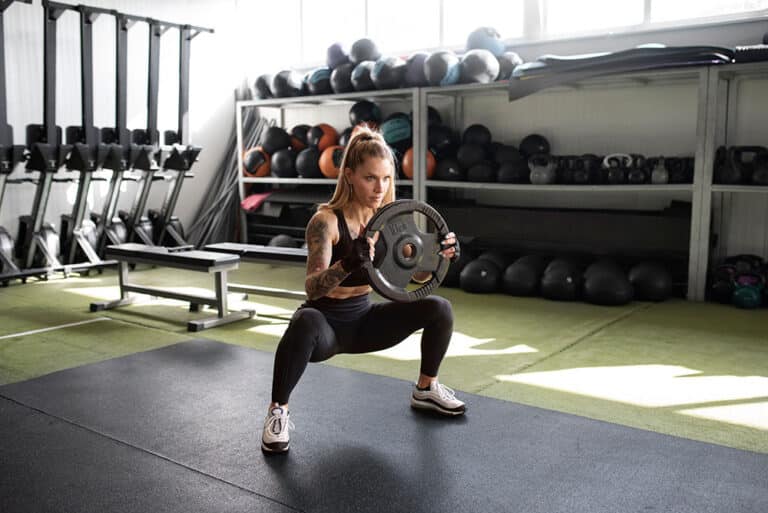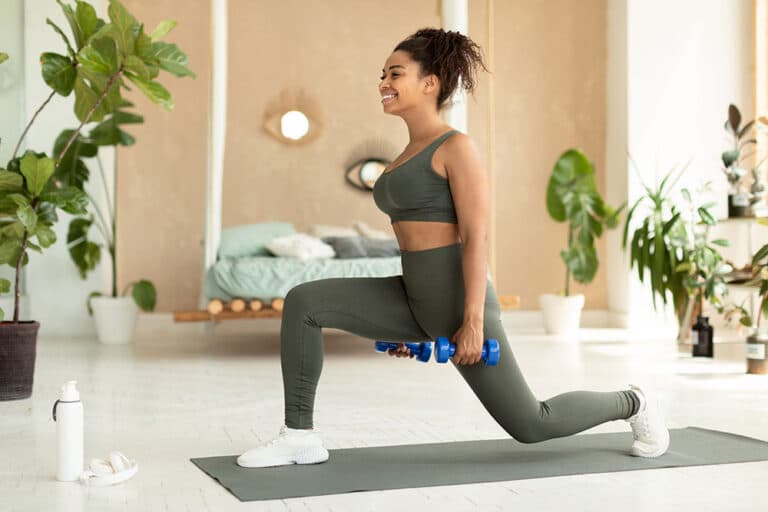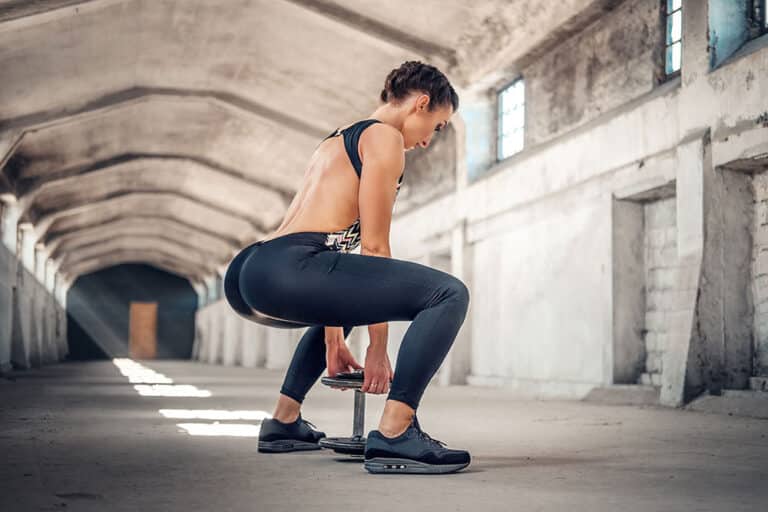Power Up with Plyometrics
Plyometric exercises bring dynamic power to your leg workouts, using explosive movements to build strength, speed, and stamina. Here’s a deep dive into what plyometrics are and how they can benefit your leg training.
Introduction to Plyometrics
Plyometrics is an exercise regime focused on rapid and powerful movements. These exercises capitalize on the stretch-shortening cycle of muscles to enhance power output and speed. Typically, plyometric leg exercises include activities like jumping, lunging, and other explosive movements.
Key Plyometric Leg Exercises:
- Squat Jumps
- Box Jumps
- Lateral Jumps
- Tuck Jumps
For beginners, it is advised to start with basic movements like how to do bodyweight squats before progressing to more complex plyometric versions.
Benefits of Plyometric Leg Exercises
The potential advantages of incorporating plyometric exercises into your leg workout routine are significant. Plyometric exercises train muscles to react swiftly and forcefully, resulting in improved power and efficiency (Medical News Today). Here are some key benefits:
-
Enhanced Power and Strength: Plyometric exercises focus on boosting the power output of your muscles. This makes them an excellent training method for athletes and fitness enthusiasts who aim to enhance their speed and strength.
-
Improved Muscle Efficiency: Regular plyometric training helps in developing neurological adaptations that improve the coordination and efficiency of muscle fibers, optimizing your overall athletic performance.
-
Increased Speed: By training your muscles to react quickly, plyometrics increases your quick-twitch muscle fibers, which helps in enhancing your sprinting and jumping abilities (PubMed).
-
Skill Development: For sports that require jumping and rapid direction changes, plyometrics is invaluable. It helps you master the skill of jumping, achieving full triple extension necessary for sports like basketball (The Basketball Doctors).
| Benefit | Description | Example Exercise |
|---|---|---|
| Enhanced Power | Boosts muscle power output and strength | Box Jumps |
| Improved Efficiency | Optimizes muscle fiber coordination and reaction | Squat Jumps |
| Increased Speed | Elevates quick-twitch muscle fibers for better sprint | Lateral Jumps |
| Skill Development | Focuses on sports-specific skills like jumping | Tuck Jumps |
By adding plyometric exercises into your routine, you not only increase leg muscle power but also improve your agility and speed. For beginners, start with easier movements and gradually increase the difficulty level. To maximize the benefits, ensure proper form and follow the safety guidelines for plyometric training. If you need more ideas for leg exercises, check out our bodyweight leg challenge or explore leg strengthening for runners.
Getting Started with Plyometrics
Plyometric exercises are excellent for enhancing leg strength, power, and overall fitness. Let’s dive into some foundational exercises for beginners and strategies for progressing in plyometric training.
Plyometric Leg Exercises for Beginners
For those new to plyometric exercises for legs, starting with basic movements can help build the necessary strength and coordination. Here are some effective beginner exercises:
Squat Jumps
Squat jumps are an excellent starting point for incorporating plyometric movements.
- Stand with feet shoulder-width apart.
- Lower into a squat position.
- Explode upward, jumping as high as possible.
- Land softly, returning to the squat position.
- Repeat for 10-15 reps.
Box Jumps
Box jumps help improve explosive power and coordination.
- Stand in front of a sturdy box or platform.
- Jump onto the box, landing with both feet.
- Step down gently and repeat.
- Perform 8-12 reps.
Lateral Jumps
Lateral jumps enhance agility and lateral strength.
- Stand with feet hip-width apart.
- Jump sideways to the right, landing softly.
- Jump back to the starting position.
- Alternate sides for 10 reps each.
| Exercise | Reps | Sets |
|---|---|---|
| Squat Jumps | 10-15 | 3 |
| Box Jumps | 8-12 | 3 |
| Lateral Jumps | 10 each side | 3 |
For more detailed instructions on specific movements, such as squats and lunges, visit our articles on how to do bodyweight squats and bodyweight lunge variations.
Progressing in Plyometric Training
Once comfortable with basic plyometrics, it’s time to gradually increase the intensity to continue making progress.
Increasing Intensity
- Height and Distance: Gradually increase the height of the box for box jumps or the distance covered in lateral jumps.
- Repetition and Sets: Incrementally add more repetitions or sets to your workout.
- Complex Movements: Integrate more challenging exercises like tuck jumps or single-leg hops.
Advanced Plyometric Exercises
As you get stronger, incorporating advanced plyometric exercises can further enhance your power:
- Tuck Jumps: Jump high and tuck your knees to your chest.
- Pistol Squat Jumps: Perform a single-leg squat, then jump explosively from the squat position. For instructions, see how to do pistol squats.
- Depth Jumps: Step off a box, land softly, and immediately jump as high as possible upon landing.
Progression in plyometric training is crucial for achieving optimal results while minimizing the risk of injury. Following a structured approach ensures safe and effective gains in strength, power, and agility. For more insights and tips, consider checking out our articles on quick leg workout no equipment and morning leg exercises.
By understanding the fundamentals of plyometrics and learning how to progress, you can effectively integrate these powerful exercises into your fitness routine and reap their numerous benefits.
Maximizing Plyometric Benefits
Understanding how to maximize the benefits of [plyometric exercises for legs] is crucial for those striving to enhance their strength, stamina, and performance. Proper technique and adherence to safety guidelines are essential to achieving optimal results while minimizing the risk of injury.
Proper Technique in Plyometrics
Good technique in plyometrics involves several key components to ensure effective and safe training:
-
Landing Mechanics: Proper landing techniques are vital to absorb the impact and reduce stress on the joints. The individual should aim to land softly on the balls of their feet, bending the knees slightly and keeping the hips back.
-
Hip-Hinge Movement: Utilizing a hip-hinge movement helps maintain balance and control. This involves bending at the hips rather than the lower back when performing jumps or bounds.
-
Arm Alignment: Arms should be kept in sync with the legs to maintain rhythm and balance during exercises. Proper arm swing can enhance the momentum and power of the movement.
-
Foot Position: Feet should be shoulder-width apart for most plyometric exercises, and the landing should mimic the starting position.
-
Core Engagement: Engaging the core muscles provides stability and protects the spine, ensuring the force generated from jumps is transferred efficiently throughout the body.
Here is a table showcasing key aspects of proper technique:
| Technique Component | Description |
|---|---|
| Landing Mechanics | Soft landing on balls of feet, slight knee bend, hips back |
| Hip-Hinge Movement | Bend at hips rather than lower back |
| Arm Alignment | Sync arms with legs, enhance momentum |
| Foot Position | Shoulder-width apart, mimic starting position on landing |
| Core Engagement | Stabilize core for efficient force transfer |
For more information on proper techniques for leg exercises, see our article on how to do bodyweight squats.
Safety Guidelines for Plyometric Training
To prevent injuries and maximize benefits, plyometric training should follow specific safety guidelines:
-
Warm-Up: A thorough warm-up prepares the muscles and joints for explosive movements. Dynamic stretches and low-intensity activities are recommended.
-
Appropriate Surface: Plyometrics should be performed on a cushioned surface, such as a rubber mat or grass, to reduce impact forces.
-
Footwear: Proper footwear with good support and cushioning is essential for absorbing shock and providing stability.
-
Progression: Exercises should progress in intensity, volume, and complexity. Start with basic movements and gradually increase the difficulty to match the individual’s capabilities and fitness level (NASM).
-
Recovery: Ensure adequate rest between sessions to allow muscles to recover and adapt. Overtraining can lead to fatigue and increase the risk of injury.
-
Body Alignment: Maintain proper alignment throughout each exercise. This includes keeping the knees aligned with the toes during squats and jumps, and avoiding excessive forward lean.
-
Quality Over Quantity: Focus on the quality of movements rather than the number of repetitions. Proper form is paramount for effective plyometric training.
For additional tips on leg exercises and how to prevent injuries, check out our guides on leg exercises for bad knees and quick leg workout no equipment.
By maintaining proper technique and adhering to safety guidelines, you can unlock the full potential of plyometric training and achieve explosive leg power while minimizing the risk of injury. For a deeper dive into the principles and science behind plyometrics, visit our section on the Stretch-Shortening Cycle in Plyometrics.
The Science Behind Plyometrics
Understanding the science behind [plyometric exercises for legs] is crucial for maximizing their benefits. Key concepts include muscle function during plyometrics and the Stretch-Shortening Cycle (SSC).
Plyometrics and Muscle Function
Plyometric training involves quick, powerful movements that include a reactive eccentric contraction followed by an explosive concentric contraction. This sequence utilizes the Stretch-Shortening Cycle (SSC) to maximize power output (NASM).
Muscles during plyometric exercises undergo three phases:
- Eccentric Phase: Pre-stretching the muscles to store elastic energy.
- Amortization Phase: Transitioning the muscle from loading energy to releasing it.
- Concentric Phase: Unloading the stored energy to release explosive force (NASM).
| Plyometric Phase | Description |
|---|---|
| Eccentric Phase | Pre-stretching the muscle fibers |
| Amortization Phase | Transition from loading to releasing energy |
| Concentric Phase | Releasing stored elastic energy |
During these phases, plyometrics enhance power output in various sports-related movements such as jumping, sprinting, and changing direction. They also aid in dynamic knee stability and injury prevention.
Stretch-Shortening Cycle in Plyometrics
The Stretch-Shortening Cycle (SSC) is integral to plyometric exercises. The SSC combines the mechanical model, which creates elastic energy in the muscle and tendon, with the neurophysiological model, which involves the stretch reflex (Physiopedia).
In simple terms, when a muscle is pre-stretched during the eccentric phase, it stores elastic energy. This stored energy is then released during the concentric phase, resulting in a powerful, explosive movement. The SSC enhances the muscle-tendon unit’s ability to produce maximum force quickly.
The term “Plyometrics” was coined by Fred Wilt and was initially known as “Jump Training” or “Stretch Shortening Cycle” as described by Yuri Verkhoshansky.
Plyometrics is not only about enhancing power but also improving muscular strength, kinesthetic control, and reducing injury risk. To achieve these benefits, it’s essential to practice proper technique and follow safety guidelines. More detailed information on these topics can be found in our sections on proper technique and safety guidelines.
By understanding the scientific principles behind plyometric training, health enthusiasts can effectively incorporate these explosive movements into their fitness routines, ensuring optimal performance and reduced injury risk. Explore more exercises to complement your plyometric training in our articles on bodyweight squats and pistol squats.
Plyometrics for Athletes
Plyometric exercises are not just beneficial for general fitness enthusiasts but also play a crucial role for athletes aiming to enhance their performance. In this section, we will explore how plyometric training significantly impacts sports performance and how athletes can effectively integrate plyometrics into their fitness programs.
Plyometric Training for Sports Performance
Plyometrics involves powerful, rapid movements designed to increase speed, power, and strength. Athletes benefit immensely from plyometrics as these exercises help improve functionalities required in sports that demand explosiveness—like sprinting, jumping, and quick directional changes (Medical News Today). Plyometric training can help athletes achieve higher vertical jumps, enhanced agility, and stronger, more powerful movements.
| Benefit | Improvement |
|---|---|
| Vertical Jump | +20% |
| Agility | +15% |
| Sprint Speed | +10% |
| Strength | +25% |
Beyond enhancing specific sport-related skills, plyometrics also contribute to injury reduction by reinforcing muscular strength and improving joint stability (NASM). Proper plyometric exercises train the body to absorb shock more effectively during high-impact movements, reducing the risk of injuries.
Integrating Plyometrics into Fitness Programs
Successfully incorporating plyometrics into an athlete’s fitness regimen requires thoughtful integration and careful planning. Plyometric training shouldn’t be done in isolation but as part of a comprehensive program that includes strength training. Athletes need to have a basic level of strength and proper landing mechanics before progressing to medium and high-intensity plyometric exercises to avoid injuries (Ultimate Athlete Project).
Here is a suggested weekly plan for integrating plyometrics with other training components:
| Day | Activity |
|---|---|
| Monday | Plyometric Training (e.g., Box Jumps, Depth Jumps) |
| Tuesday | Strength Training (Leg-focused) |
| Wednesday | Rest or Active Recovery |
| Thursday | Plyometric Training (e.g., Bounding, Skipping) |
| Friday | Sports-Specific Skill Training |
| Saturday | Strength Training (Full-body) |
| Sunday | Rest or Light Stretching/Yoga |
Athletes should ensure that they rest adequately between plyometric sessions—1-2 days of rest is typically recommended to prevent overtraining and allow muscle recovery (The Basketball Doctor). Focusing on quality movements over quantity and performing plyometrics before strength training or conditioning can maximize the benefits from these high-intensity exercises.
Plyometrics are versatile and can be adapted to various parts of the body. While primarily known for lower body exercises, upper-body plyometrics like plyometric push-ups, wall throws, and overhead throws can also be beneficial.
For those interested in exploring more leg-focused exercises, check out our tutorials on:
- [how to do bodyweight squats]
- [bodyweight leg challenge]
- [bodyweight lunge variations]
- [calf exercises without weights]
By integrating a well-rounded program that includes plyometric training, athletes can improve their overall performance, minimize injury risk, and enhance their sports-specific skills.
Beyond Legs: Plyometrics for Strength
While plyometric exercises are often associated with leg power, they are also beneficial for developing strength in other areas of the body. In this section, we’ll explore upper body plyometric exercises and how plyometrics can be utilized for full-body strength.
Upper Body Plyometric Exercises
Upper body plyometric exercises can be incredibly effective for athletes and fitness enthusiasts looking to enhance explosive power in the arms, shoulders, chest, back, and core. These exercises are particularly beneficial for sports like baseball, swimming, boxing, and martial arts (Medical News Today).
Some popular upper body plyometric exercises include:
- Plyo Pushups: This exercise involves pushing off the ground with enough force to lift the hands off the floor.
- Wall Plyometric Pushups: Performed against a wall, this exercise targets the chest and arms and can be adjusted for difficulty.
- Medicine Ball Slams: Releasing a medicine ball onto the ground from an overhead position, this exercise targets the core, shoulders, and back.
Here is a table of upper body plyometric exercises:
| Exercise | Targeted Muscles |
|---|---|
| Plyo Pushups | Chest, Shoulders, Triceps |
| Wall Plyometric Pushups | Chest, Shoulders, Triceps |
| Medicine Ball Slams | Core, Shoulders, Back |
Plyometrics for Full-Body Strength
Plyometric exercises are not limited to just the upper or lower body. Full-body plyometric routines can lead to enhanced overall strength, speed, and endurance.
Full-body plyometric exercises might include:
- Burpee Box Jumps: This combines the standard burpee with explosive box jump, engaging multiple muscle groups.
- Squat to Press: Using weights, perform a squat and then press the weights overhead in one explosive movement.
- Jumping Lunges: Alternating lunges with a jump to switch legs.
| Exercise | Targeted Muscles |
|---|---|
| Burpee Box Jumps | Legs, Core, Shoulders, Back |
| Squat to Press | Legs, Shoulders, Core |
| Jumping Lunges | Legs, Core, Glutes |
For a comprehensive list of leg-focused plyometric exercises and more detailed information on enhancing leg power, check out our article on [bodyweight leg challenge].
The science behind plyometric training is deeply rooted in the mechanics of muscle function. Plyometrics involve an eccentric phase (pre-stretching the muscles), an amortization phase (transition from loading to releasing energy), and a concentric phase (unloading stored elastic energy for explosive power).
Incorporating these exercises into your fitness routine can maximize strength and performance across multiple muscle groups, providing a balanced and powerful workout. For further guidance on safe practices and techniques, visit our section on [tips for straightening curly hair].
- About the Author
- Latest Posts
Johnnie D. Jackow Sr., the founder and CEO of Total Body Fitness, Worldwide, has a long-standing career in the fitness industry. He began as a certified personal trainer in the mid-90s and soon after authored his first weight loss book in 1998. This led to the launch of Total Body Fitness, Nationwide in the USA at the same time. Johnnie gained recognition as the fitness guru of his time, running infomercials on local TV late at night in Houston, Texas. Over the years, he has helped more than 40,000 individuals from all over the world achieve their health and fitness goals. With over 60,000 hours of documented training in integrative functional medicine, he completed his PhD in human physiology in 2010. His primary objective is to assist people in reaching their health and fitness goals through alternative approaches rather than relying solely on conventional medicine and pharmaceutical drugs. Today, with almost three decades of experience under his belt, Johnnie continues to be a leader in health and fitness.








